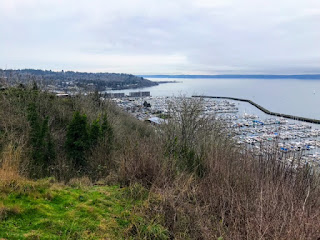 |
| Looking west in 2010 from about here on the Strait of Juan de Fuca. Photo by Hugh Shipman |
This weekend I took advantage of the good low tides to trek out west for a walk on the fascinating shoreline near the West Twin River. A notable feature on this shoreline used to be the "mole" that served a former clay mine that is currently owned by LaFarge North America, and which is the low, pier-like feature in Hugh Shipman's 2010 photo above. This mole was indeed used as a wharf, to load barges of mine material when the mine was active. In 2016 the company removed the mole as part of the requirements associated with their aquatic lands lease, and the Coastal Watershed Institute was contracted and designed a removal approach relying largely on natural erosion to re-distribute the fill material making up the core of the mole. As a result Hugh Shipman's 2010 view looks quite a bit different:
 |
| 1 May 2021 photo looking west at the former site of the LaFarge clay mine mole. |
This is another example of a very short-term, restoration-driven change to the shoreline, similar to the Elwha restoration example posted here.













